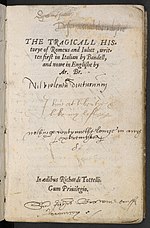Dieses Wiki, das alte(!) Projektwiki (projektwiki.zum.de)
wird demnächst gelöscht.
Bitte sichere Deine Inhalte zeitnah,
wenn Du sie weiter verwenden möchtest.
Gerne kannst Du natürlich weiterarbeiten
im neuen Projektwiki (projekte.zum.de).About the play
The tragedy "Romeo and Juliet" was first performed around 1596 and quickly became one of the most famous plays by William Shakespeare. It deals with the feud between two powerful families in Verona, Italy and the tragic affair between the two young lovers Romeo and Juliet.
Inspiration
While writing the drama, Shakespeare had different sources of inspiration, one of the main sources being the poem "Tragical History of Romeus and Juliet" (1562) by Arthur Brooke. Brooke's poem was based on a French version of said poem by Bandello from 1554, which was inspired by the 1525 interpretation by Luigi da Porto of a story by Massuccio Salernitano from 1476. While Shakespeare stayed mostly true to his source, he changed a few aspects in the process of writing. He changed small details like the age of Juliet (making her 13 instead of 16), but he also altered the pacing dramatically. Instead of making the events take place over the span of three months, he condensed the timespan to a few days. Both changes have an impact on the tone of the tragedy.
The drama was first published on paper in 1597, but was soon to be replaced by a newer version two years later. In 1609 and 1623 Shakespeare published two other versions. While the first version is criticised for being a copy of Arthur Brooke's poem, the second one is considered as Shakespeare's "rough draft".
Language
While the story of Romeo and Juliet may not be original, Shakespeare was able to create an unique story that is still read to this day with his use of language. He often makes use of powerful imagery, which helps understand a scene without many props. Furthermore, Shakespeare employs puns, oxymorons, ambiguity, etc. to entertain his audience. The ambiguity, created with suggestive language, innuendos and allusions, make his dramas more exciting as well. To properly let his characters express themselves, Shakespeare even invented new words, some of which are still used today.
Throughout the play, the shift in Romeo's and Juliet's language as they fall in love is very noticeable. As Romeo falls in love with Juliet his language becomes richer and stronger, even though it was normal before. In general, the characters make oaths, swear, and banish each other. They show language skill through an overuse of action verbs.
Popularity and Importance
While Romeo and Juliet was certainly popular when it was first published, the drama has only gained popularity over time.
Today, it has been filmed and newly interpreted numerous times, with popular examples like the 1996 movie "Romeo + Juliet" by Baz Luhrman or Prokofiev's ballet.
Shakespeare has even been considered to be the inventor of the modern idea of love. While texts like "The Odyssey" by Homer have already dealt with love and affection, Shakespeare introduced the quality of love as we know it today. In a time of chaos because of the modernisation he proposed love as an answer. With his depiction of love, he was the first in the western world to introduce society to an idea of love that is applicable to everyone (no matter their social status) and as important as we perceive it today.
Sources: gradesaver.com, sparknotes.com, nebo-lit.comThe Nerdwriter


